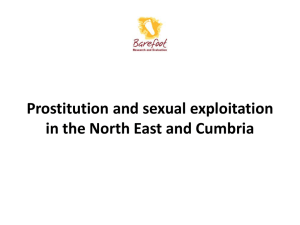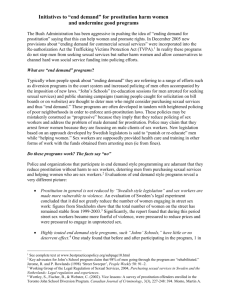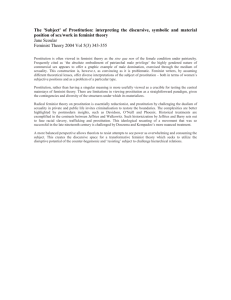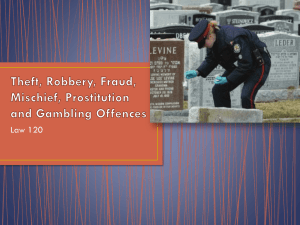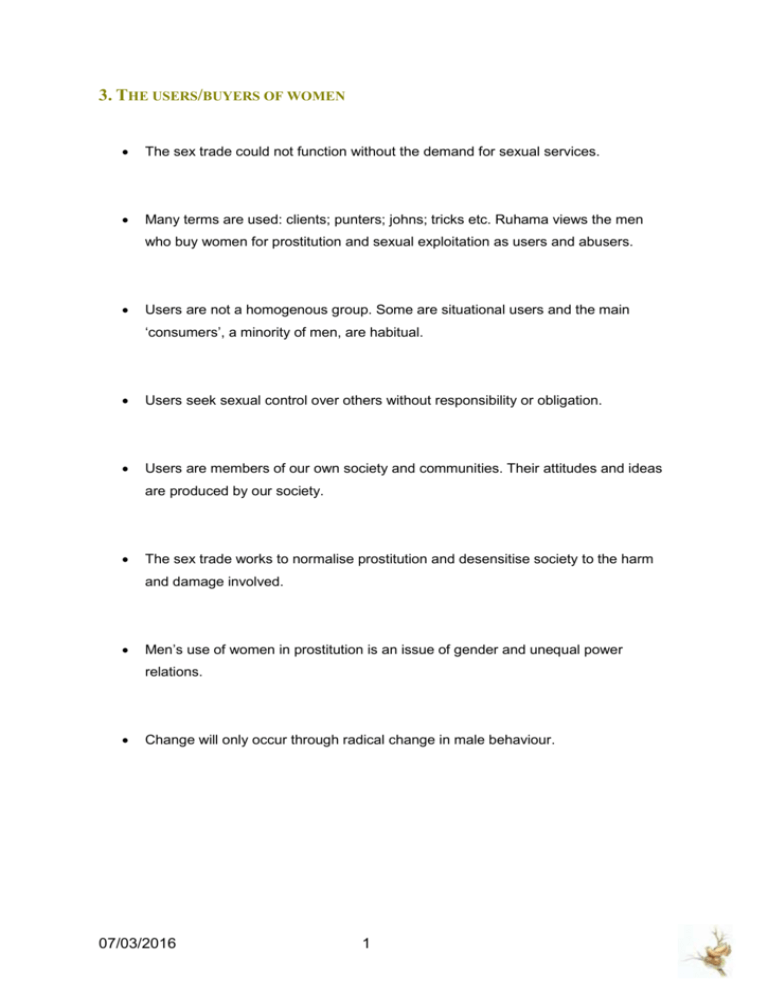
3. THE USERS/BUYERS OF WOMEN
The sex trade could not function without the demand for sexual services.
Many terms are used: clients; punters; johns; tricks etc. Ruhama views the men
who buy women for prostitution and sexual exploitation as users and abusers.
Users are not a homogenous group. Some are situational users and the main
‘consumers’, a minority of men, are habitual.
Users seek sexual control over others without responsibility or obligation.
Users are members of our own society and communities. Their attitudes and ideas
are produced by our society.
The sex trade works to normalise prostitution and desensitise society to the harm
and damage involved.
Men’s use of women in prostitution is an issue of gender and unequal power
relations.
Change will only occur through radical change in male behaviour.
07/03/2016
1
3. THE CLIENTS/USERS OF WOMEN IN PROSTITUTION
Users and abusers
Various terms are used to describe the users: clients, customers, punters, johns, tricks.
Ruhama views the men who buy women for prostitution and sexual exploitation as users
and abusers.
The term ‘pimp’ describes one who lives off the proceeds of prostitution and pimping is
illegal in all countries. Men who pimp are frequently in relationship with the women they
abuse, as lovers, boyfriends, and husbands. There are those also, however, who argue
that some states and governments are now functioning as pimps where prostitution is
legalized and regulated through licensing fees and taxation.
Control with avoidance of dependency and obligation
Through the payment of women in prostitution, clients believe they can manage their
sexual and emotional life as they choose, can dominate and treat a woman as nothing but
a sexually objectified body etc with no obligations or expectations, no threat of mutual
dependency. The female’s behaviour is controllable through the simple medium of money
or sometimes other goods or ‘favours’ and the younger and more vulnerable the more
controllable.
Julie O’Connell Davidson, for her book, Prostitution, Power and Freedom, (1998)
interviewed more than 350 Western men about their prostitute use in the course of
research into prostitution and sex tourism over seven years. Her central conclusion and a
recurrent theme in other studies is that the use of women in prostitution represents a
means of sidestepping certain aspects of social regulation of sexual life, a way of attaining
power and control over other people as sexual beings without incurring dependencies or
obligations.1
07/03/2016
2
Not a homogenous group
The evidence from studies shows that, while there are commonalities, the users or buyers
of women do not form a homogenous group. A distinction can be made between ‘habitual’
and ‘situational’ prostitute users.
Though only a minority of men habitually use women in prostitution, this minority
nevertheless ‘consumes’ a large quantity of prostitution contracts.2 Figures relating to
London in 2001 show 8.9% of men aged 16-44 reported having paid for sex in the past 5
years3 This minority furnishes the demand for both adults and minors in the sex trade.
Without them the sex trade could not exist on its current scale and others would not find
themselves in the ‘situations’ where prostitution use seems normal, acceptable and
harmless.
Large numbers of sex tourists – men and women, can be termed situational users. They
find themselves in situations where they have not intended to have sex with a
woman/man/child in prostitution, but can tell themselves that here it is acceptable/different
and that the person is not really in prostitution and that they are not really paying for sex.
Habitual ‘users’ make a conscious choice about using women in prostitution. According to
the renowned Swedish sociologist, Sven Axel Mansson, the clients may be split into 70%
occasional (single or rare incident) and 30% habitual (more than twenty contacts). Habitual
clients are not numerous but regularly use a large number of women. 4 These users
project their emotional problems onto women, using violence in varying degrees to
humiliate and degrade them. According to Mansson, these men are not very receptive
to legal measures and present a major challenge in terms of prevention.
Studies show certain trends among users, e.g. that the largest group of users are
men between the ages of 30 and 39 and the majority are or have been married or
cohabiting and often have children. Most frequent profiles are of a user that is
around 30 yrs old, married, in full time employment with no criminal convictions.5
O’Connell Davidson, J.(1998) p.189 also Mansson S.A. (2002) McKeganey, N. and Barnard, M., (1996)
and Lawless, K & Wayne, A., and Ruhama, The Next Step Initiative, (2005)
2
O’Connell Davidson, J., (1998) and Mansson, S.A., (2002)
3
National Survey of Sexual attitudes and Lifestyles in Britain, 2001 - in British home office consultation
paper (2004) Paying the Price p.17
4
www.sisyphe.org. article ‘The need for a Debate on Prostitution and its Social Consequences’ retrieved
11.5.06
5 Mansson, S.A., (1984) Sisyphe article cited above. Also British Home Office (2004).
1
07/03/2016
3
In a British Home Office Study on street prostitution in 2004, figures, supplied by
police, for men soliciting women, show a median age of 35; most (67%) in fulltime
employment; most white European; nearly half married; nearly half are owner
occupiers and most have no previous charges. 6 A Swedish National Institute of
Public Health study found that one man in eight in Sweden buys sex at least once
in his life. They come from a cross section of social classes, have money, stability,
education and power – in contrast to the women they buy.7
Research dispels the myths surrounding the picture of client as victim, as lonely, deviant,
powerless, unattractive, and therefore, having no option other than buying women in
prostitution. Studies also agree that the issue of power and control is the key one.8
As well as the absence of obligation and the need for domination, men cite other reasons –
as they see it, the payment allows the men to specify certain sex acts; have sex with a
range of women; have sex with women with particular physical attribute/image; to behave
violently and sadistically without the sanction of the ‘normal’ laws against violence and
harassment: to experience the thrill of socially illicit acts and to buy the illusion of intimacy.9
Social attitudes sustain sexual exploitation
Addressing the issue of the clients or customers is a difficult but crucial confrontation. To
do so is to be forced into confronting many uncomfortable realities about who these
customers are, who it is that forms the clientele that buys women for prostitution and
sexual exploitation. It is also to be faced with the many myths surrounding prostitution and
men’s sexuality that underpin the trade in sexual exploitation.
The reality is that most of the European and western men who pay for sex with women in
prostitution - including child prostitutes at home and abroad, hold attitudes that are
perfectly in tune with their own societies dominant popular discourses on gender, sexuality,
race. They are products of our own societies, of our deeply embedded attitudes to
6
Home Office Research Study, no.279, (2004)
Swedish Government Publication ‘Prostitution and trafficking in human beings’ N5029,
www.sweden.gov.se
8
Mansson S.A., (2001); McKeganey, N., and Bernard, M., (1996)
9
Lawless, K., And Wayne, A., and Ruhama (2005) p.63
7
07/03/2016
4
sexuality, to men and women’s relationships and roles and to sex as a consumer
product/marketing strategy rather than an aspect of intimate relationship.
Normalisation and prevailing attitudes
Under the pressure of massive marketing campaigns and consumerism, our society is
becoming desensitised to, and socialised, to tolerate massive global, class, race and
gender inequalities. These inequalities are, as far as possible, rendered invisible to the
consumers of cheap consumer goods, package holidays, low paid domestic workers etc
and ultimately cheap sex with no obligations.
Sex is portrayed as an irresistible physical need with men, by nature, having irrepressible
sexual desires, somehow, conferring rights to fulfilment, including the right to purchase
women’s sexuality as another commodity. The sex in prostitution is presented as satisfying
a perfectly understandable and reasonable demand on the part of the ‘consumer’. 10
Within the consumerist framework, because money is involved, the pretence can be
maintained that the sex is consensual and harmless. The actual reality, the harm, the
highly conditioned nature of the women’s choice or compliance can be disregarded.
An economic analysis is very necessary to understand the push and pull factors in
prostitution but it is insufficient for explaining the behaviour of the buyers of women in
prostitution. It leaves untold the tolerated and/or accepted “natural law” of male sexuality –
that men’s alleged innate sexual needs must be satisfied and therefore prostitution is
inevitable.11
The marketing and myths hide the reality that there is always harm involved, that violence
is inherent in prostitution, that a high majority of women have been assaulted, terrorised,
beaten, raped and that there are devastating psychological consequences comparable to
those of rape and the most severe post traumatic stress disorders ( See paper 2, the
harm). At an individual level, clients can evade a sense of moral responsibility – they can
claim that they do not force the women to embrace the experience – she does so for
economic reasons, or because she is under compulsion from some third party. They may
even claim that they are the passive beneficiaries of harm inflicted by other persons and
structures12
10
O’Connell Davidson, J., (STOP report) p.38
11
Hynes and Raymond (2002)
12
O’Connell Davidson, J., (1998) p.207
07/03/2016
5
An awareness of how we, as a society, construct gender and sexuality: femininity and
masculinity is key in appreciating the operation and impact of the rapidly increasing sex
trade. Vast resources are being poured by the sex trade into marketing and glamorising
sexual exploitation, with the aim of desensitising people to the very real harm involved.
What is needed is, what Mansson terms, a radical reconsideration of men’s responsibility
in prostitution that would reframe prostitution as a question of men’s sexuality not
women’s.
The unpalatable truth from studies is that those who use and abuse women in prostitution
are members of our own society, and are produced by us. 13 If we ignore that reality, we
are in danger of formulating policies that, at best, do nothing meaningful to address the
problem, and at worst, intensify the vulnerability of those already most vulnerable within
prostitution.14
It is an urgent and timely issue in Ireland where attention is finally being given to the
problem of trafficking for sexual exploitation – clearly inextricably linked to prostitution.
Ruhama, together with colleagues in international NGOs, has long pointed out that the
source of the trafficking problem is prostitution – without a tolerance for prostitution there
would be no ‘market’ to support trafficking. Trafficking can never be tackled successfully
without addressing the underlying cause – as is evident in countries such as the
Netherlands, Germany and states in Australia where the legalisation of prostitution has led
to an increase in trafficking and the prostitution of minors.
Prostitution as a Gender Issue
The existence of prostitution affects each person’s sexuality and all of our human
relationships. ‘Prostitution is an industry that arises from women’s low social status and the
relegation of women to the role of sex objects.’15 It is an industry ‘that arises from the
historical subordination of women and the historical right of men to buy and exchange
women simply as objects for sexual use.’16
(Mansson, S.A., (2002), O’Connell Davidson J., (in STOP report)
O’Connell Davidson (STOP), p.35
15
Sullivan, M.,and Jeffreys, S., 2002. P.11
16
Sullivan, M.,and Jeffreys, S., 2002 . P.12
13
14
07/03/2016
6
If the sexes were equal, women would not be sexually subjugated. If they were equal,
women would not be economically subjected, their desperation and marginality cultivated,
their enforced dependency exploited sexually or economically. 17.
Prostitution is one of the most extreme signs of a lack of mutuality and equality between
men and women. It aggravates and deepens mutual misunderstanding and contempt,
upholding relationships based on violence and domination.
Prostitution and sexual exploitation maintain women’s social inequality and hinder
progress for the future by reinforcing archaic, macho attitudes such as the idea that a
woman’s primary role is to satisfy men’s sexual fantasies.
The normalisation of sexual exploitation reinforces the gender subordination of women in
the public economy18. It also originates in that same gender inequality and in
unquestioned and unchallenged assumptions about femininity and masculinity. The sex
industry is a constantly expanding obstacle to women’s struggle to improve their status.
Locally and globally the situation of women remains unequal. Globally, the situation of
women in developing countries is worsening, as the sex trade itself becomes a
development strategy. In areas where unemployment and poverty are widespread and
where governments are desperate for revenue and hard currency many women see sex
work in sex tourism as a way of survival and advancement for themselves and their
families. 19
Radical change
As Mansson argues, it is a fact that the majority of men still take advantage and benefit
from the overall subordination of women. The truth of the matter is that men’s interests in
patriarchal power is consolidated and defended by most of the cultural machinery
surrounding our everyday lives’.20 At the heart of the issue is the need for male behaviour
change and unless there is an acceptance of this analysis, legal mechanisms, while
important, will never achieve the radical change required to end prostitution and sexual
exploitation.
17
McKinnon, C., (1989) p.215.
Barry, K. (1996) p.102
19
Brennan, D., (2003)
20
Mansson, S.A., (2002) p.14
18
07/03/2016
7
In 1999, the groundbreaking Swedish Law That Prohibits the Purchase of Sexual Services
was enacted based on the premise that prostitution is an aspect of male violence against
women, is a form of exploitation of women and children and is harmful not only to the
individual but to society at large.21 Importantly, the law is accompanied by public
education, awareness raising and victim support. Together with changes in other laws on
violence and sexual harassment, this law criminalises the purchasers and pimps and
decriminalises the victims. The Swedish government seeks to establish zero tolerance for
prostitution and trafficking, clear that the two are inextricably linked and that without the
demand they would not exist. 22
Sources and further reading:
Barry, K.(1996) ‘The Prostitution of Sexuality: A Cause for International Human Rights’, in
Hayes, A., Lyons, A., and Shaughnessy, L., (eds) Review, Vol.4 at 95-108. Galway: UCG
Women’s Studies Centre.
Brennan, D., (2003) ‘Selling Sex for Visas: Sex Tourism as a Stepping Stone to
International Migration’ in Ehrenreich, B., and Russell Hochschild, A., (eds.) Global
Woman; Nannies, Maids and Sex Workers in the New Economy London: Granta Books at
154 – 168.
British Home Office (2004) Paying the Price: a consultation paper on prostitution. London:
Home Office Communication Directorate.
.
British Home Office Research Study, no.279, (2004), Tackling Street Prostitution:
Towards an holistic approach, London: Home Office Research, Development and
Statistics Directorate
Coalition Against Trafficking in Women - Asia Pacific. ’Sex: From intimacy to "sexual
labor" or Is it a human right to prostitute?’ www.catwinternational.org
Ekberg, G. (2004) The Swedish Law That Prohibits the Purchase of Sexual Services’, Best
Practices for Prevention and Trafficking in Human Beings, in Violence Against Women,
Vol. 10, at 1187-1218.
Hynes, P., & Raymond, J., (2002), ‘Put in Harms Way: The Neglected Consequences of
Sex Trafficking in The United States’, in Silliman, J. & Bhattacharjee, A., (eds) Policing the
National Body:Sex, Race and Criminalisation. Cambridge, Massachusetts: South End
Press
21
Swedish Government Publication N5029, www.sweden.gov.se and Ekberg G., (2004)
Swedish Government Publication ‘Prostitution and trafficking in human beings’ N5029,
www.sweden.gov.se
22
07/03/2016
8
Jeffreys, S., (1997) The Idea of Prostitution, Melbourne: Spinifex Press
Lawless, K., and Wayne, A., (2005) for TSA Consultancy and Ruhama, The Next Step
Initiative: Research Report on Barriers Affecting Women in Prostitution, Dublin: Ruhama
McKeganey, N. and Barnard, M. (1996) Sex Work on the Streets: Prostitutes and their
Clients. Buckingham: Open University Press
McKinnon, C., (1989) Towards a Feminist Theory of the State, Cambridge: Harvard
University Press.
Mansson S. A. (2002) ‘Men’s Practices in Prostitution: The case of Sweden’ in Bob Pease
and Keith Pringle (eds.) A Man’s World: Changing Men’s Practices in a Globalised World,
London Zed Books
O’Connell Davidson, J. (1998) Prostitution, Power and Freedom, Oxford: Polity Press,
O’Connell Davidson, J. (‘Punter Fiction – Stories Clients Tell About Their Prostitute Use’ in
Jyrkinen, M. and Karjalainen, L., (eds) Minors in the Sex Trade, Report of the European
Commission STOP Project
Sisyphe ‘The need for a Debate on Prostitution and its Social Consequences’ www.
sisyphe,org
Sullivan, Mary and Jeffreys, Sheila. ‘Legalising Prostitution Is Not the Answer: The
Example of Victoria, Australia’. www.catwinternational.org
Swedish Government Publication ‘Prostitution and trafficking in human beings’ N5029,
www.sweden.gov.se
Web Sites:
www.catwinternational.org
www.prostitutionresearch.com
www.sisyphe.org
www.sweden.gov.se
07/03/2016
9





